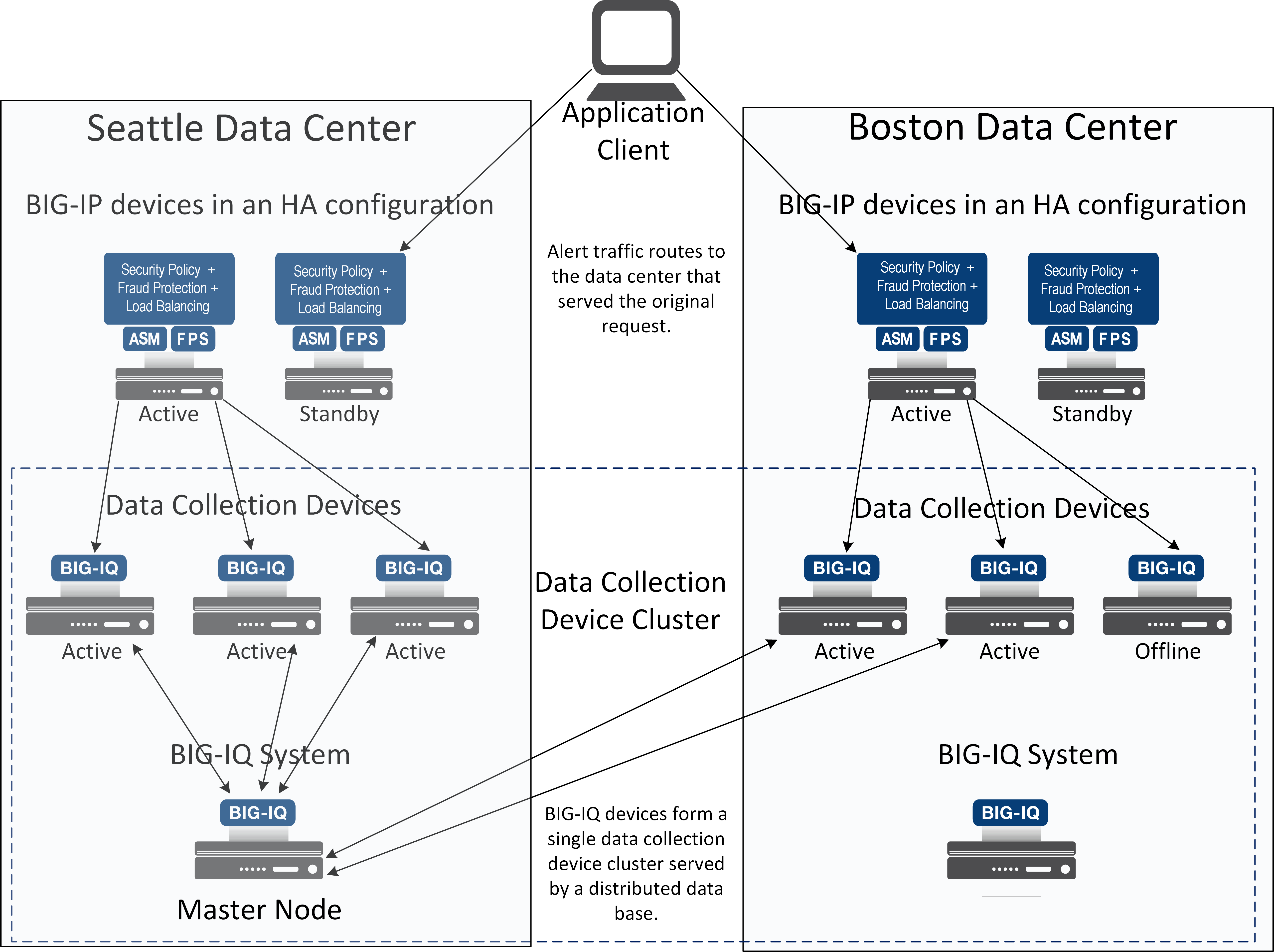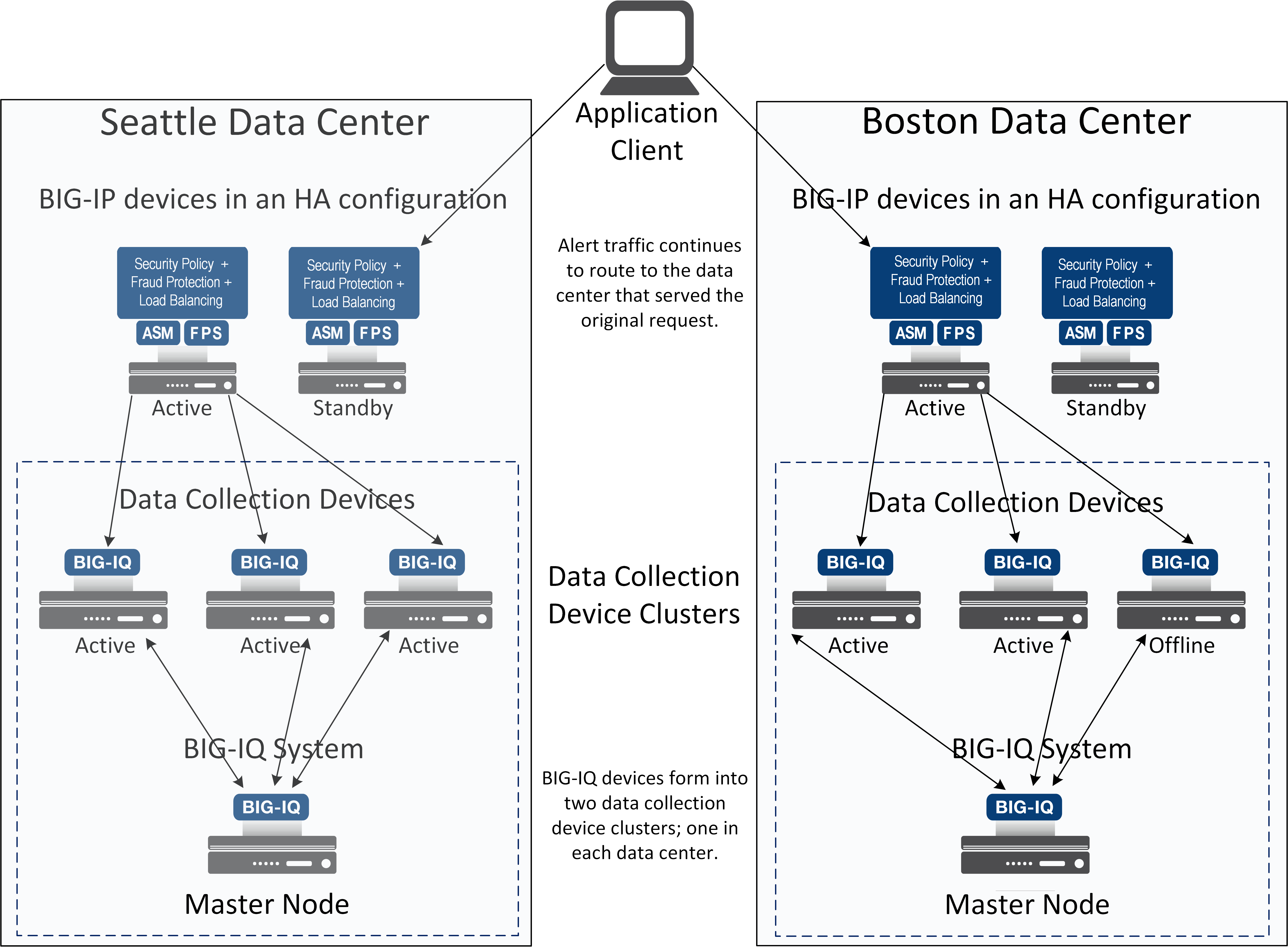Applies To:
Show Versions
Managing Disaster Recovery Scenarios with Two Data Centers
How does a data collection device cluster deal with disaster recovery scenarios?
The BIG-IQ system uses high availability and zone awareness functions to maintain data collection device (DCD) operations even when a node or an entire data center goes down. DCDs in each data center are assigned to the appropriate zone. This zone awareness enables the system to manage the distribution of your data and maintain DCD operation in all but the most severe outages.
For a better understanding of how this process works, consider the following example. A hypothetical company named Acme has two data centers; one in Seattle and the other in Boston. Acme wants to ensure data reliability, and has set up these data centers so that if one goes offline, the DCD data it was receiving is routed to the other data center. To achieve this, Acme has an HA pair of BIG-IQ systems for viewing and managing the data, and six DCDs divided equally between the two data centers. Two BIG-IP devices are used to load balance data and configure Fraud Protection Services and Application Security Manager settings for both data centers.
The HA pair ensures that one BIG-IQ system is always available for managing configuration data. The standby system is available for viewing configuration data, and managing data. The DCDs are treated as one large cluster that is split between two sites. Each data node is replicated, so that if one goes down, or even if an entire data center goes down, the data is still available.

Two data centers, one DCD cluster example
The DCD cluster logic that governs the distribution of data between your DCDs identifies one node in the cluster as the master node. The master node monitors the cluster health and manages the cluster operation. It is elected by the cluster, and can reside on any node. (The BIG-IQ system, however, does not store any data.) If a master node goes down, a new master is elected from among all the nodes in the cluster.
How does the minimum master eligible devices setting work?
One parameter of special significance in determining the behavior of the data collection device (DCD) cluster is the minimum master eligible devices (MMED) setting. All of the devices in the cluster (including the primary and secondary BIG-IQ systems) are eligible to be the master device.
When a device is added or removed from the DCD cluster, the system performs a calculation to determine the optimum default value. You can override the default value to suit your requirements.
This setting determines how many DCDs in the cluster must be online for the cluster to continue to process alert data. If your goal is to keep operating regardless of device failures, it might seem like the obvious choice would be to set this number to as low a value as possible. However, you should keep in mind a few factors:
- The BIG-IQ system is counted as a device in the cluster, so a cluster size of 1 does not make sense.
- Similarly, a cluster size of 2 (a DCD and the BIG-IQ console) is not a good idea. Because the DCD cluster logic uses multiple DCDs to ensure the reliability of your data, you need at least two logging devices to get the best data integrity.
- It might also seem like a good idea to set the MMED to a higher value (for example, one less than the number in the entire cluster), but actually, best practice is to not specify a value larger than the number of devices in one zone. If there is a communications failure, the devices in each zone compose the entire cluster, and if the MMED is set to a lower value, both clusters stop processing data.
How is alert data handled when data collection devices fail?
Here are some of the most common failure scenarios that can occur to a data collection device cluster, and how the cluster responds to that scenario.
| What failed? | How does the cluster respond? |
|---|---|
| One of the data collection devices fails. | All alert data, including the data that was being sent to the failed node, is still available. When a node is added, removed, or fails, the cluster logic redistributes the data to the remaining nodes in the cluster. |
| The master node fails. | The cluster logic chooses a new master node. This process is commonly referred to as electing a new master node. Until the new master is elected, there may be a brief period during which alert processing is stopped. Once the new master is elected, all of the alert data is available. |
| All of the data collection devices in a zone fail. | Just as when a single data collection device fails, the cluster logic redistributes the data to the remaining nodes in the cluster |
How is data handled when communication between the two data centers fails?
This scenario is a little more complex than the case where data collection devices fail, so it needs a little more discussion to understand. However, it's also much less likely to occur. The cluster behavior in this scenario is controlled by the Minimum Master Eligible Devices (MMED) setting. The default MMED setting is determined by a simple formula: the (total number of nodes / 2) + 1. This setting should handle most scenarios. Before you consider changing the default setting, you should learn more about how the Elasticsearch logic uses it. Refer to the article on discovery.zen.minimum_master_nodes in the Elasticsearch Reference, version 6.3 documentation.
You do not control which node is the master, but the master node is identified on the Cluster Settings tab of the BIG-IQ Data Collection Configuration page. Considering the two-data-center scenario discussed previously, let's assume that the master node is in the Seattle data center. If communication goes down between the data centers, the Seattle data center continues to function as before, because with four nodes (the BIG-IQ system and three DCDs) it satisfies the MMED setting of 3. In the Boston data center, a new master node is elected because without communication between the two data centers, the Boston data center has lost communication with the master node. Since the Boston data center also has four master eligible nodes, it satisfies the MMED setting. The Boston data center elects a new master and forms its own cluster. So, once the two new master nodes are elected, BIG-IP devices in each data center send their alerts to the DCDs in their own cluster, and the master node in each zone controls that zone.

Two data centers form two DCD clusters following a communications failure
When communication resumes, the cluster that existed before the failure does not reform on its own, because both data centers have formed their own independent clusters. To reform the original cluster, you can restart the master node for one of the clusters. However, reforming the cluster without first doing a couple of precautionary steps is not generally the best practice because you will lose some data.
What happens to your data if you just reform the cluster
- If you decide to restart the master node in the Boston data center when communication is restored, the cluster logic sees that the Seattle data center already has an elected master node, so the Boston cluster joins the Seattle cluster instead of forming its own. The Seattle master node then syncs its data with the Boston nodes in the cluster. The data sync overwrites the Boston data with the Seattle data. The result is that Boston data received during the communication failure is lost.
- If you decide to restart the master node in the Seattle data center when communication is restored, the cluster logic sees that the Boston data center already has an elected master node, so the Seattle cluster joins the Boston cluster. The Boston master node then syncs its data with the nodes in the Seattle cluster. That data sync overwrites the Seattle data with the Boston data. The result is that Seattle data received during the communication failure is lost.
How to preserve the maximum amount of data
To preserve as much data as possible, F5 recommends that, instead of just reforming the original cluster by restarting one of the clusters, you perform these two precautionary steps.
- When a communication failure occurs, change the target DCDs for the BIG-IP devices in the zone that did not include the original master node (Boston, in our example) to one of the DCDs in the zone that housed the original master node (Seattle, in our example).
- When communication is restored, in the zone that did not include the original master node (Boston, in our example), use SSH to log in to the master node as root, and then type bigstart restart elasticsearch , and press Enter. Restarting this service removes this node from the election process just long enough so that the original (Seattle) master node can be elected.
After you perform these two steps, all alerts are sent to nodes in the zone that contained the original master node. Then when communication is restored, the DCDs in the zone where the master node was restarted (Boston in our example) rejoin the cluster. The resulting data sync overwrites the Boston data with the Seattle data. The Seattle data center has the data that was collected before, during, and after the communications failure. The result is that all of the data for the original cluster is saved and when the data is synced, all alert data is preserved.





